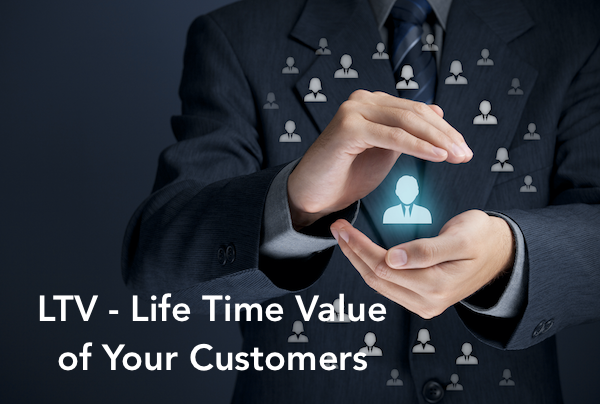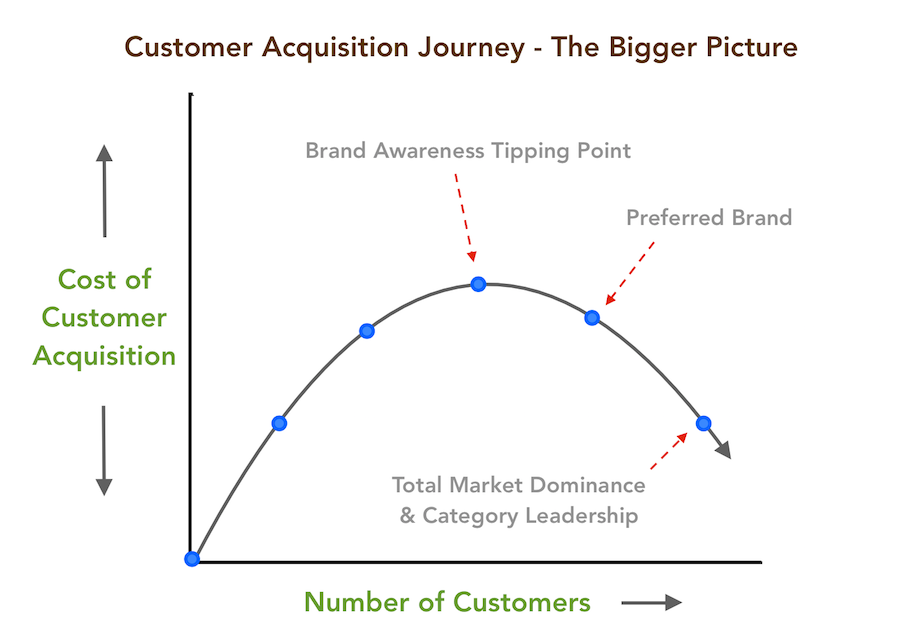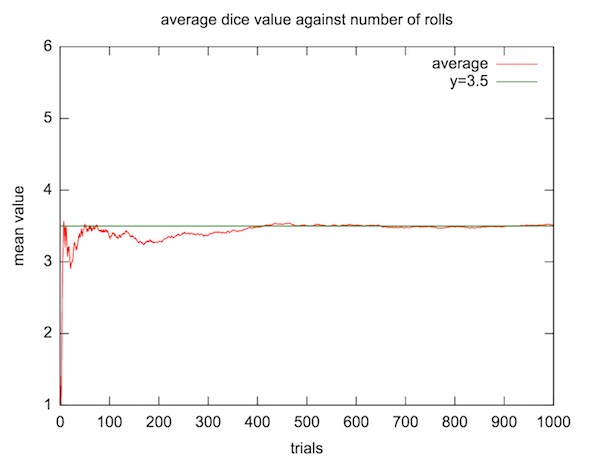Why LTV of Your Customers is The Important Metric in Marketing

When it comes to digital marketing, everyone talks about the various channels of advertising such as AdWords, Facebook etc. Then people talk about metrics like CPC, Conversions etc. But one of the most important metrics that I see being constantly missed out is LTV – Life Time Value of your customers.

The Life time value means the total revenue that your customers are going to bring to your business over a period of time. “Life” here can be a year, two years or five years depending on the business. In certain categories like automobiles, a customer remains loyal to a brand for as high as 15-20 years or even more.
This metric is so important because it determines how much you can spend on digital marketing (or any marketing channel) to acquire one customer. Without knowing your LTV, you are just shooting in the dark, and you will have no idea if your business is going to fail or succeed.
How to Calculate the LTV of Your Customers?
Let’s say you sell a SaaS (software as a service) product. You charge your customers Rs.500 a month to use your product. Some customers will use your product for a long time, but some customers will drop off after a few months. Let’s say, on average, a customer uses your product for 15 months, then the total revenue that you make from that customer is Rs.7,500. This number is your LTV.
If you are selling information products, you are not going to make a profit by selling just one product. You need to have a sales funnel where you sell a low priced item first and then move your customers to higher commitments. Here you can calculate the average value of a subscriber entering your funnel. For example, in my sales funnel, a subscriber brings in a revenue of Rs.50 on average. As long as the cost to acquire a subscriber is less than Rs.50, I am in profit.
For this article, let us take the example of the SaaS product we discussed above where the LTV is Rs.7,500. You can improve the LTV by creating a better product, identifying and rectifying the reasons why your customers drop off and with better customer education. There are many ways to increase your customer’s LTV, but that’s a topic for another day. Let us assume that you have reached the maximum possible LTV of Rs.7,500 per customer on average.
CAC – Cost of Acquiring a Customer
The amount of marketing budget that you spend to acquire one customer is CAC – Cost of Acquiring a Customer. For the sake of simplicity let’s assume there are no other overheads in running the business. If you spend Rs.7,500 to acquire this customer, then let’s assume you just break even.
Now, to make a profit, you need to spend less than your LTV to acquire a customer. Let’s say you spend Rs.5,000 to acquire a customer. This means that you invest Rs.5,000 in marketing to get a customer who will bring a revenue of Rs.7,500 over a period of 15 months.
In the above scenario, you end up making a profit of Rs.2,500. (To keep it simple, I am not including the cost of funds here. In real world scenario, if you have to borrow Rs.5,000 to invest in marketing, you will also have to pay interest on it so your actual profits will be much lower).
Now that you are making a profit of Rs.2,500 from every customer, it may look like you can acquire as much customers as you can and keep expanding your business.
But we have another challenge: unlike LTV, the CAC (Cost of acquiring a customer) does not remain constant. Why? Because it becomes harder and harder to find customers for your product or service over time.
To give you an analogy: If you are looking for smooth, round pebbles near a river bank – it is easy to find the first few. Harder to find the next few. Hardest to find the last few.
When you have developed a product or service, you can get the first few customers through your personal network (assuming you have a product-market fit in the first place). Here the CAC is zero. You call people up, ask them to sign up & you have acquired customers at Rs.0.

Then you go for other marketing channels where the cost per acquisition is low – let’s say low hanging fruits. Here it is more of growth hacks than traditional marketing.
You are hacking your growth curve by coming up with innovative ideas to acquire customers. Growth hacking involves marketing activities that are innovative and not generally followed by every business in the market. Since the competition in such activities is low, the CAC is also low.
All growth hacking methods eventually become traditional marketing strategies as everyone starts following them. For example, content marketing and search engine marketing used to be growth hacks around 2009-2010.
People who knew how to advertise on the search engines acquired customers at a really low cost. Slowly, the popularity of certain marketing channels spread. People write about it, speak about it & consult about it. Once everyone starts using them, they lose their advantage as growth hacks and they become traditional marketing methods.
Once these acquisition channels are depleted, you need to go deeper into the market. Here’s where the cost per customer acquisition becomes really high. Because through marketing and advertising you are hitting a lot more people than required. Expanding on the same analogy – if you want to find the last few round pebbles on a river bank, you need a lot of people who will spend a lot of time searching for them.
Can CAC be higher than your LTV?
At a certain point, your CAC becomes as high as your LTV. In fact in many competitive markets, the CAC is higher than the LTV to start with. It would look like it is almost impossible to penetrate such markets because the unit economics just wouldn’t work out. For every customer acquired, you would be in net loss. (For example, the Indian e-commerce companies).
What’s the point in investing more money to acquire a single customer that would generate lesser revenue than what you spent to get them in the first place? In the long term, if your product is really really good, it does make sense to acquire these early customers at a very high cost, because you will eventually become the market leader.
When you become the market leader, you need not reach out to customers. They will reach out to you. You will still be acquiring a lot of customers through paid marketing channels, but you will also be getting a good percentage of customers via organic channels. This will reduce your average CAC.
In the following chart, you can see that at a certain point your CAC starts going down. This is what I call ‘The Brand Awareness Tipping Point’. After this point, it is a smooth ride. It’s like cycling up the hill and then enjoying your ride downhill.
Your CAC will keep going down (assuming that you have the best product in the category). It will go down to a point where you will be getting most of your customers for free. You will still be spending money on branding and marketing but you wouldn’t need to.

For example, if you look at Google AdWords as a product, they acquire a lot of customers for free. For search engine marketing, their obvious choice is Google AdWords. That’s because Google has become a market leader in search engines and search engine marketing.
A lot of brands and products have become market leaders in a specific category. They acquire customers at zero cost. If you want the best car, bike, watch, laptop or whatever – you would go for the best one in the market. The product doesn’t need to advertise itself to you to make you buy it. You buy the product because you want the best.
All marketing activities to should lead a brand to category leadership. That’s the very purpose of marketing. Eventually marketing should lead to a point where no marketing is required.
If you have a mediocre product your CAC will never come down and your business will eventually die a slow painful death. Even businesses who make profits in early stages eventually shut shop if their product cannot reach leadership level.
Law of Large Numbers & Regression to the Mean
It is extremely challenging to calculate LTV for a business. That’s why very few startups succeed. It has to be noted that the LTV becomes stable only with large numbers. Here, LLN (Law of large numbers) deserves a mention.
From Wikipedia:
In probability theory, the law of large numbers (LLN) is a theorem that describes the result of performing the same experiment a large number of times. According to the law, the average of the results obtained from a large number of trials should be close to the expected value, and will tend to become closer as more trials are performed. The LLN is important because it “guarantees” stable long-term results for the averages of some random events.
To give you a simple example: If you throw a dice 6 times, there is a very little probability that you will get 1, 2, 3, 4, 5 & 6 each time. However if you throw a dice 6,000 times, you will get each number approximately a 1,000 times. You may get one 950 times. Two – 1020 times, and so on.
But imagine that, you throw a dice 6 million times, each number will be much closer to a million in terms of % than when you did it 6,000 times. The law of large numbers guarantees that you will get a specific number very close to 1/6th of the total throws of the dice. Larger the numbers involved, the closer it gets to the expected value.
So when you calculate LTV, the larger the number of existing customers you have, the more accurate this number will be. But that doesn’t mean you shouldn’t try to measure LTV. Even if you have just 10 customers, you should estimate a number for your LTV and try to work with that. Eventually with more customers, your LTV will become more and more accurate.

Regression to the Mean
Another important statistical concept we have to take into account is Regression to the Mean.
According to Wikipedia:
In statistics, regression toward (or to) the mean is the phenomenon that if a variable is extreme on its first measurement, it will tend to be closer to the average on its second measurement—and if it is extreme on its second measurement, it will tend to have been closer to the average on its first.
Let’s say you have an LTV that is accurate enough to start a new marketing campaign. When you start acquiring new customers, these customers are not going to give you the expected LTV. The first customer may drop off immediately. The second customer may give you higher than expected LTV. But when you acquire more and more customers, their LTV will regress towards the average LTV that you have calculated before. Regression to the mean is closely linked to LLN.
Entering New Markets
If you are a startup entering a new market, it doesn’t matter how many competitors you have or how much it costs to acquire customers. As long as the market is big enough and as long as your product is better than your competitors, you can eventually become the market leader. All the investments will pay off big time after you cross the brand awareness tipping point.